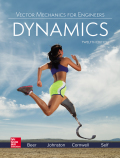
Concept explainers
A belt of negligible mass passes between cylinders A and B and is pulled to the right with a force P. Cylinders A and B weigh, respectively, 5 and 20 lb. The shaft of cylinder A is free to slide in a vertical slot and the coefficients of friction between the belt and each of the cylinders are
i.
If there is any slipping between the belt and the cylinders and the angular acceleration of two cylinders.
Answer to Problem 16.39P
There is slipping between cylinder b and belt.
Angular acceleration of cylinder a =
Angular acceleration of cylinder A =
Explanation of Solution
Given:
weight of Cylinder A, wa = 5 lb radius of cylinder A = 4 in.
weight of cylinder B, wb = 20 lb
radius of cylinder B, rB = 8 in.
Magnitude of Force pulling the belt = 3.6 lb
Coefficient of static friction = 0.5
Coefficient of kinetic friction = 0.4
Concept used:
Condition of non-slipping,
Friction force due to static friction must be greater than the pulling force on each cylinder.
Fs> FA, Fs>FB
Mass moment of inertia for a disk is given by-
The tangential force acting on a cylinder will provide the angular acceleration to the cylinder. Therefore,
Calculation:
Mass of cylinder A =
Mass of cylinder B =
Mass moment of inertia of cylinder A =
Mass moment of inertia of cylinder B =
For cylinder A,
For cylinder B,
the net force on the belt should be summation of P, force by cylinder B and force by cylinder C, all equals to 0.
Maximum friction force to avoid slipping Fs =
Condition of slipping is
Conclusion:
There is slipping between cylinder b and belt.
ii.
As there sliping, find the angular acceleration of two cylinders.
Answer to Problem 16.39P
Angular acceleration of cylinder a =
Angular acceleration of cylinder A =
Explanation of Solution
Given:
weight of Cylinder A, wa = 5 lb radius of cylinder A = 4 in.
weight of cylinder B, wb = 20 lb
radius of cylinder B, rB = 8 in.
Magnitude of Force pulling the belt = 3.6 lb
Coefficient of static friction = 0.5
Coefficient of kinetic friction = 0.4
Concept used:
Condition of non-slipping,
Friction force due to static friction must be greater than the pulling force on each cylinder.
Fs> FA, Fs>FB
Mass moment of inertia for a disk is given by-
The tangential force acting on a cylinder will provide the angular acceleration to the cylinder. Therefore,
Calculation:
Mass of cylinder A =
Mass of cylinder B =
Mass moment of inertia of cylinder A =
Mass moment of inertia of cylinder B =
Assuming slipping,
For cylinder B,
Next, for the belt,
Since
There is no slipping on cylinder A
Conclusion:
Angular acceleration of cylinder a =
Angular acceleration of cylinder A =
Want to see more full solutions like this?
Chapter 16 Solutions
Vector Mechanics For Engineers
- Solve this problem and show all of the workarrow_forwardSolve this problem and show all of the workarrow_forwarddraw the pneumatic circuit to operate a double-acting cylinder with: 1. Extension: Any of two manual conditions plus cylinder fully retracted, → Extension has both meter-in and meter-out, 2. Retraction: one manual conditions plus cylinder fully extended, → Retraction is very fast using quick exhaust valve.arrow_forward
- Correct answer is written below. Detailed and complete solution with fbd only. I will upvote, thank you. Expert solution plsarrow_forwardCorrect answer is written below. Detailed and complete solution with fbd only. I will upvote, thank you.arrow_forwardCorrect answer is written below. Detailed and complete solution with fbd only. I will upvote, thank you.arrow_forward
- Correct answer is written below. Detailed and complete solution only with fbd. I will upvote, thank you.arrow_forwardCorrect answer is written below. Detailed and complete solution only. I will upvote, thank you.arrow_forwardCorrect answer is written below. Detailed and complete solution with fbd only. I will upvote, thank you.arrow_forward
- Correct answer is written below. Detailed and complete solution only. I will upvote, thank you.arrow_forwardCorrect answer is written below. Detailed and complete solution with fbd only. I will upvote, thank you.arrow_forwardCorrect answer is written below. Detailed and complete solution only. I will upvote, thank you.arrow_forward
 International Edition---engineering Mechanics: St...Mechanical EngineeringISBN:9781305501607Author:Andrew Pytel And Jaan KiusalaasPublisher:CENGAGE L
International Edition---engineering Mechanics: St...Mechanical EngineeringISBN:9781305501607Author:Andrew Pytel And Jaan KiusalaasPublisher:CENGAGE L
